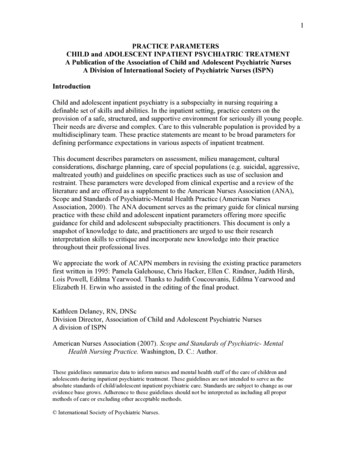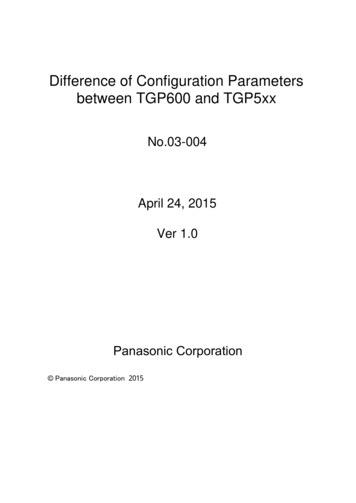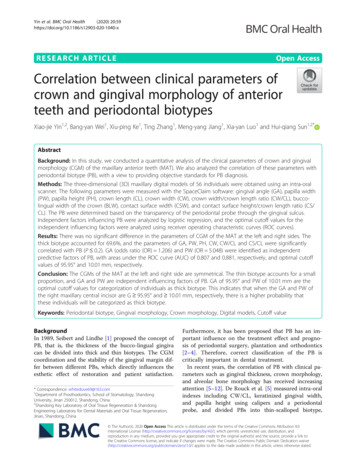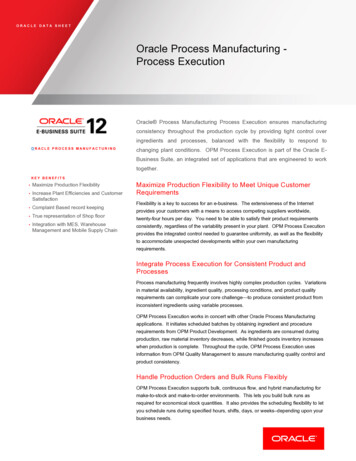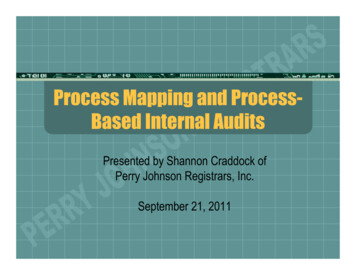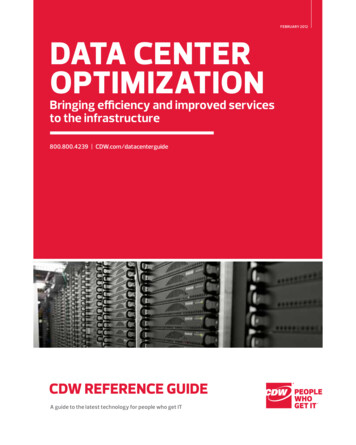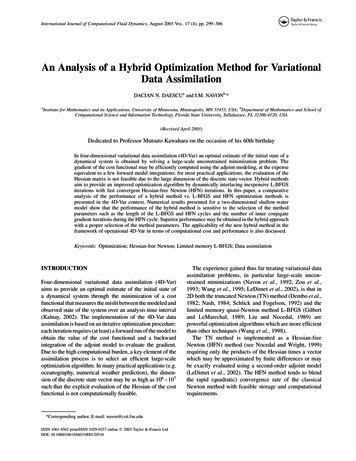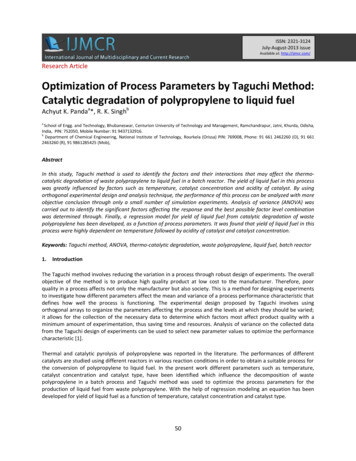
Transcription
ISSN: 2321-3124July-August-2013 issueAvailable at: http://ijmcr.com/Research ArticleOptimization of Process Parameters by Taguchi Method:Catalytic degradation of polypropylene to liquid fuelAchyut K. Pandaa*, R. K. SinghbaSchool of Engg. and Technology, Bhubaneswar, Centurion University of Technology and Management, Ramchandrapur, Jatni, Khurda, Odisha,India, PIN: 752050, Mobile Number: 91 9437132916.bDepartment of Chemical Engineering, National Institute of Technology, Rourkela (Orissa) PIN: 769008, Phone: 91 661 2462260 (O), 91 6612463260 (R), 91 9861285425 (Mob),AbstractIn this study, Taguchi method is used to identify the factors and their interactions that may affect the thermocatalytic degradation of waste polypropylene to liquid fuel in a batch reactor. The yield of liquid fuel in this processwas greatly influenced by factors such as temperature, catalyst concentration and acidity of catalyst. By usingorthogonal experimental design and analysis technique, the performance of this process can be analyzed with moreobjective conclusion through only a small number of simulation experiments. Analysis of variance (ANOVA) wascarried out to identify the significant factors affecting the response and the best possible factor level combinationwas determined through. Finally, a regression model for yield of liquid fuel from catalytic degradation of wastepolypropylene has been developed, as a function of process parameters. It was found that yield of liquid fuel in thisprocess were highly dependent on temperature followed by acidity of catalyst and catalyst concentration.Keywords: Taguchi method, ANOVA, thermo-catalytic degradation, waste polypropylene, liquid fuel, batch reactor1.IntroductionThe Taguchi method involves reducing the variation in a process through robust design of experiments. The overallobjective of the method is to produce high quality product at low cost to the manufacturer. Therefore, poorquality in a process affects not only the manufacturer but also society. This is a method for designing experimentsto investigate how different parameters affect the mean and variance of a process performance characteristic thatdefines how well the process is functioning. The experimental design proposed by Taguchi involves usingorthogonal arrays to organize the parameters affecting the process and the levels at which they should be varied;it allows for the collection of the necessary data to determine which factors most affect product quality with aminimum amount of experimentation, thus saving time and resources. Analysis of variance on the collected datafrom the Taguchi design of experiments can be used to select new parameter values to optimize the performancecharacteristic [1].Thermal and catalytic pyrolysis of polypropylene was reported in the literature. The performances of differentcatalysts are studied using different reactors in various reaction conditions in order to obtain a suitable process forthe conversion of polypropylene to liquid fuel. In the present work different parameters such as temperature,catalyst concentration and catalyst type, have been identified which influence the decomposition of wastepolypropylene in a batch process and Taguchi method was used to optimize the process parameters for theproduction of liquid fuel from waste polypropylene. With the help of regression modeling an equation has beendeveloped for yield of liquid fuel as a function of temperature, catalyst concentration and catalyst type.50
Achyut K. Panda et alInternational Journal of Multidisciplinary and Current, July-August-2013 issue2. Materials and methodsIn this experiment waste polypropylene (disposable glass) was degraded using different kaolin clay based catalystsof different acidity values which mostly affect the process.The waste polypropylene is identified by the DSC of the sample that gives the melting point of the waste sample tobe 171 C, which ensures the samples to be polypropylene.Commercial grade kaolin clay procured from Chemtex Corporation, Kolkata, India was used as catalyst in thepyrolysis reaction. The chemical composition of the kaolin sample was found to be SiO 2 43.12 %, Al2O3 46.07 %,Fe2O3 nil, MgO 0.027 %, CaO 0.030 %, ZnO 0.0064%, K2O 0.01%, TiO2 0.74, LOI at 1000 C 9.9%. The chemicalactivation/modification of kaolin was carried out by adding 50g of the clay to 500ml of sulphuric acid solution ofdifferent concentrations (1M, 3M, 5M) and refluxing at 110 C under the atmospheric pressure in a roundbottomed flask equipped with a reflux condenser for 4 hours. The resulting clay suspension was then rapidlyquenched by adding 500ml ice cold water. The content was then filtered, repeatedly washed with distilled water toremove any unspent acid, dried in an oven, calcined at 500 C for one hour and ground in a mortar pastel topowder form. The untreated sample is referred to as KC and treated samples are referred to as KC1M, KC3M, andKC5M in the subsequent text where the numbers refers to the different concentration of acid used. The detailcharacterization of the different clay materials are described in our previous work [2]. The acidity of the differentclay materials used is mentioned in Table 1.Table 1 Acidity of different clayCatalystKCKC1MKC3MKC5MAcid centers (mmol/g)0.0490.1080.1160.210The experimental setup used in this work consists of a batch reactor made of stainless steel (SS) tube (length- 145mm, internal diameter- 37 mm and outer diameter- 41 mm) sealed at one end and an outlet tube at other end andis as shown in previous study [3]. The SS tube is heated externally by an electric furnace, with the temperaturebeing measured by a Cr-Al: K type thermocouple fixed inside the reactor and temperature is controlled by externalPID controller. Shimaden PID controller SR1 was used to control the temperature of the furnace. The accuracy ofthis PID controller is 0.3% FS (FS 1200ºC). So the temperature can be measured with 3.6ºC. 20g. of wastepolypropylene samples were loaded in each pyrolysis reaction. In the catalytic pyrolysis, a mixture of catalyst andthe plastics samples in different catalyst to plastics proportion was subjected to pyrolysis in the reactor set up andheated at a rate of 20 C/min. up to the desired temperature. The condensable liquid products were collectedthrough the condenser and weighed. After pyrolysis, the solid residue left out inside the reactor was weighed.Then the weight of gaseous product was calculated from the material balance. Reactions were carried out atdifferent temperatures ranging from 400-550 C.The statistical analysis has been done using MINITAB 14 software with Taguchi method.3. Design of experiments in present experiment3.1 Taguchi approach to parameter designIn the present work, experimental work has been designed in a sequence of steps to insure that data is obtained ina way that its analysis will lead immediately to valid statistical inferences. This research methodology is termed asDESIGN OF EXPERIMENT (DOE) methodology. DOE using Taguchi approach attempts to extract maximumimportant information with minimum number of experiments [4]. Taguchi techniques are experimental designoptimization techniques which use standard Orthogonal Arrays (OA) for forming a matrix of experiments. Using anOA to design the experiment helps the designer to study the influence of multiple controllable factors on the51
Achyut K. Panda et alInternational Journal of Multidisciplinary and Current, July-August-2013 issueaverage of quality characteristics and the variations in a fast and economic way. OA’s allow screening out fewimportant main effects from the many less important ones. Also it allows us to estimate interaction effects if anyand determine their significance [1].In the present reaction system three operating parameters, each at three levels, are selected to evaluate yield ofliquid fuel. The factors to be studied are mentioned in Table 2. Based on Taguchi method, the L27-OA wasconstructed. The reason for using L27-OA is to evaluate the significance of interaction terms. Interaction means theinfluence of an operating variable on the effect of other operating variable [5].Table 2 Factors and their levels in the experimental designLevelTemperature [T](ºC)Catalyst type defined by their acidity[A] (mmol/g)Plastics to catalyst ratio [C]1234505005500.0490.1080.2103610In the present work only second order interaction terms have been considered viz., (T*A), (T*C), (A*C) but not thethird order viz., (T*A*C) where [T temperature, A acidity of different catalysts, C plastic to catalyst ratio].The experiments were carried out according to the L 27-OA. The yield of liquid fuel (in wt.%) was considered asTaguchi array response. The L27-OA and response values for yield of liquid fuel are shown in Table 3.Table 3 L27-OA response values and S/N ratio for yield of liquid re(T)11111111122222222233Catalyst type in terms ofacidity(A)Plasticstocatalystratio (C)yield of liquid product inwt.% 290.689.291.473.5552S/N 6.90238.0073
Achyut K. Panda et alInternational Journal of Multidisciplinary and Current, July-August-2013 7.875237.65053.2 Analysis of dataAfter conducting the experiment, the results were converted into S/N ratio values. The final L27-OA displayingresponse values and their corresponding S/N ratio values for yield of liquid fuel are shown in Table 3.3.2.1 Main Effect PlotMain effects plot for the main effect terms viz. factors T, A and C are shown in Figure 1. From the main effect plots,it has been observed that yield of liquid fuel increases with increase in temperature from 450ºC to 500ºC anddecreases with further increase in temperature from 500ºC to 550ºC due to the formation of more noncondensable gaseous/volatile fractions by rigorous cracking at higher temperature. Yield of liquid fuel increaseswith use of different catalyst of increasing acidity and increase in plastic to catalyst ratio owing to the increase inthe acid centers which is mainly responsible for cracking process.Main Effects Plot (data means) for MeansTA8784Mean of Means817875450500C55036100.0498784817875Figure 1 Main effect plots530.1080.210
Achyut K. Panda et alInternational Journal of Multidisciplinary and Current, July-August-2013 issue3.2.2 Interaction PlotWhether interactions between factors exist or not can be shown by plotting a matrix of interaction plot. Parallellines in an interaction plot indicate no interaction. However, the interaction plot doesn't tell if the interaction isstatistically significant [6].Interaction plots are most often used to visualize interactions during DOE. Matrix of interaction plot for yield ofliquid fuel is shown in Figure 2. It can be seen visually that there are non-parallel lines between temperature andacidity of the catalyst (T and A).The plastic to polymer ratio (C) does not show any significant interaction (parallellines) for yield of liquid fuel.Interaction Plot (data means) for 1080.210709080C3610C704505005503610Figure 2 Interaction plot4. Result evaluationThere are two different methodologies in carrying out the complete OA analysis. A common approach is to analyzethe average result of repetitive runs, or a single run, through ANOVA analysis [4]. Since in the present work there isonly one replication, further analysis of OA is done through ANOVA. Once the data for a designed experiment havebeen collected, the sample information is used to make inferences about the population means associated withthe various treatments. The method used to compare the treatment means is known as analysis of variance, orANOVA [[W. Mendenhall et al., 1989]].An ANOVA Table breaks down the effect of each factor and the experimental error. In addition, it will also breakdown all of the possible interactions of the factors. In the present work ANOVA Table for yield of liquid fuel fromwaste polypropylene has been shown in Table 4 using MINITAB 14 software. In this process, it is seen that thesignificant factors are temperature (T), catalyst type in terms of acidity (A), interaction between temperature andacidity (T*A) and plastic to catalyst ratio (C), written in the decreasing order of significance.54
Achyut K. Panda et alInternational Journal of Multidisciplinary and Current, July-August-2013 issueTable 4 Analysis of Variance for Means (ANOVA).SourceDFSSMSPTACT*AT*CA*CResidual .0000.0000.0050.0030.5450.8861.075It is seen that the (T*A*C) term has completely vanished. The reasoning for this would be that since all threefactors and four interactions use up the 26 degree of freedom in this experiment, there was nothing left over withwhich to measure the error. The solution to this predicament was to pool the effect of non-significant factors andinteractions. Interaction (T*A*C) had very small variance. Therefore its degree of freedom and their sum ofsquares had been pooled together. These pooled figures are removed from their places on the ANOVA Table andan error factor is created [6].The final ANOVA Table for percentage contribution (exact value in percent) of each of the significant factors inaffecting the response value, which is calculated on the basis of ANOVA Table, is shown in Table 5. The significantmain effect terms and interaction terms in the ANOVA Table 5 are computed using the F-r
The statistical analysis has been done using MINITAB 14 software with Taguchi method. 3. Design of experiments in present experiment 3.1 Taguchi approach to parameter design In the present work, experimental work has been designed in a sequence of steps to insure that data is obtained in a way that its analysis will lead immediately to valid statistical inferences. This research methodology is .
